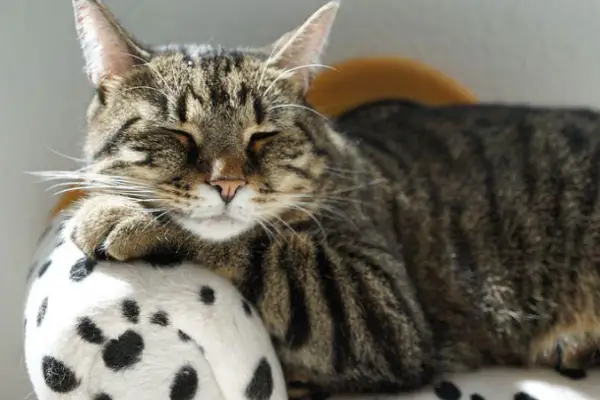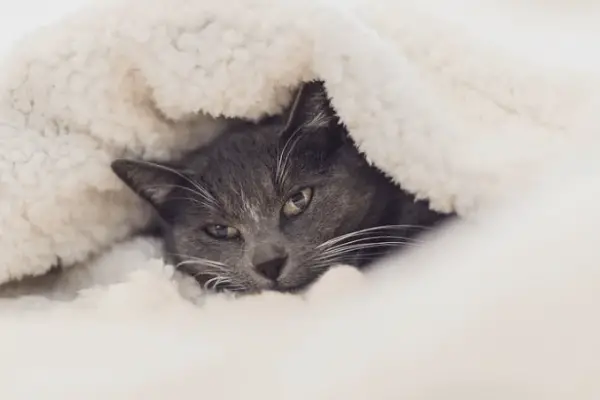How Do Cats Get Leukemia [9 Top Ways]
![How Do Cats Get Leukemia [9 Top Ways] How Do Cats Get Leukemia](https://petcreeks.com/wp-content/uploads/2023/04/How-Do-Cats-Get-Leukemia.jpg)
How do cats get leukemia? Let’s find out together…
Worried about your feline friend and the possibility of them contracting leukemia? Wondering how cats get this disease? We’ve got you covered!
In this short blog post, we’ll explore the ways in which cats can get leukemia and what you can do to help protect your furry companion.
So, sit back, grab a cup of tea, and let’s dive in…
What is the feline leukemia virus (FeLV)?
Feline leukemia virus (FeLV) is a virus that infects cats and is one of the most common infectious diseases in cats in the United States.
It was first discovered in cats with a form of leukemia, which is a cancer of the white blood cells.
FeLV is transmitted between cats via infected saliva and urine and can be spread through direct contact with these body fluids, mutual grooming, shared litter boxes, and more.
FeLV is a retrovirus belonging to the coronavirus subfamily, which means it is a cancer-causing virus that only affects cats.
FeLV weakens a cat’s immune system and can lead to various health problems.
Vaccines are available, but currently, no vaccine offers 100% protection against the virus.
Now you know what cat leukemia is, let’s discuss how cats get it…
How Do Cats Get Leukemia
Feline leukemia virus (FeLV) is typically spread from cat to cat via close contact with infected and non-infected cats.
The virus is normally spread via saliva, blood, and to some extent, urine, and feces.
FeLV can be transmitted from an infected mother cat to her kittens, either before they are born or while they are nursing.
It is important to note that all cats can become infected with FeLV, though kittens or cats with already weakened immune systems are more susceptible.
It can also be spread through blood, urine, and feces to some extent, and it is important to note that the virus does not live long outside the body.
Allowing an unvaccinated cat to be unsupervised while outdoors may increase their risk of contracting FeLV.
Let’s break it down further…
Ways cats get leukemia
Here are some common ways cats can get infected with feline leukemia:
1. Mother-to-Kitten Transmission
FeLV is a retrovirus that can be passed from an infected mother to her unborn child through breastfeeding or during pregnancy.
FeLV infection during pregnancy greatly increases the likelihood that the kittens will also contract the disease.
Because of this, it’s crucial to test pregnant cats for FeLV and to keep infected moms away from their young.
2. Sharing Litter Boxes
FeLV can be spread through contaminated feces and urine when a cat shares a litter box with an infected cat.
There is a chance of transmission if an uninfected cat uses the same litter box as a healthy cat.
To lower the danger of transmission, litter boxes should be cleaned frequently, and each cat should have their own box.
3. Bite Wounds From Infected Cats
The leukemia virus can spread by saliva if an infected cat bites an uninfected cat.
This is because FeLV can infect white blood cells, lowering immunity and increasing the risk of infection in cats.
Vaccinating cats regularly can help lower their risk of contracting an infection.
Sharing water and food bowls with a cat that is infected can spread FeLV through saliva.
Separating the dishes for cats are advised to stop the illness from spreading.
Additionally, washing water and food dishes frequently might aid with infection prevention.
5. Direct Contact with Infected Cats
Through intimate touch, FeLV can spread from one cat to another.
Cats may groom one another, share food and water bowls, or even just be in close proximity to one another when this occurs.
Transmission of the virus can also happen when cats fight.
Learn more about how to know if a cat has parasites.
6. Outdoor Exposure
Cats who spend a lot of time outside have a higher chance of coming into touch with FeLV-positive cats.
Thus, keeping cats inside can aid in lowering the risk of infection.
It is advised to have cats frequently tested for FeLV and to keep up with their vaccines if outside exposure cannot be avoided.
7. Blood Transfusions
Blood transfusions can result in the transmission of FeLV, thus it’s crucial to make sure that any blood products given to cats are free of the virus.
It’s crucial to request FeLV-free blood if your cat needs a transfusion.
8. Weaker Immune System
FeLV infection is more likely to occur in cats with compromised immune systems.
Particularly at risk are kittens, senior cats, and cats who have health issues already.
To lessen the chance of exposure, it’s critical to give these cats a healthy diet, regular veterinary exams, and indoor housing.
9. Casual Cat Fighting
Cats that fight each other run the danger of contracting FeLV since the virus can be spread through saliva, blood, urine, and feces.
The virus can be spread by even innocuous contact, such as grooming each other.
Neutering male cats is crucial to lowering the risk of fighting and illness since male cats are more prone to fighting.
Learn more about how indoor cats get parasites.
Symptoms of Feline Leukemia Virus
Feline Leukemia Virus (FeLV) is a retrovirus that attacks the immune system of cats, making them susceptible to other infections and diseases.
FeLV can lead to many different symptoms in cats, some of which are more common than others.
Here are some common symptoms of FeLV in cats:
- Lethargy and Weakness: Cats infected with FeLV often become lethargic and have less energy than usual. They may appear weak or have difficulty moving around.
- Loss of Appetite: Cats with FeLV may lose their appetites and refuse to eat. This can lead to significant weight loss and malnutrition.
- Fever: A fever is a common symptom of FeLV, and infected cats may show signs of fever such as lethargy, reduced appetite, and increased respiratory rate.
- Diarrhea and Vomiting: FeLV infection can cause digestive issues such as diarrhea and vomiting. This can lead to dehydration and further weight loss.
- Respiratory Problems: FeLV can cause respiratory problems such as difficulty breathing, coughing, and wheezing.
- Enlarged Lymph Nodes: Cats with FeLV may have enlarged lymph nodes, which can be felt as lumps under the skin.
- Skin and Coat Problems: FeLV infection can cause skin and coat problems such as dry, flaky skin, hair loss, and dull or greasy fur.
- Dental Problems: FeLV can cause dental problems such as gum disease and tooth decay. Infected cats may have bad breath and difficulty eating due to pain or discomfort.
- Increased Susceptibility to Infections: FeLV weakens the immune system, making infected cats more susceptible to other infections and diseases.
Learn more about ways cats get bacterial infections.
Prevention and control measures for feline leukemia virus
Here are some common prevention and control measures for the feline leukemia virus:
- Vaccination: There are several vaccines available that can help prevent FeLV infection. Consult with your veterinarian about the most appropriate vaccine for your cat based on their age, outdoor access, and lifestyle.
- Cat confinement: Keeping cats indoors can significantly reduce their risk of contracting and spreading FeLV, especially if they live in areas with high feline density.
- Cat testing: Testing your cat for FeLV on a regular basis can help detect the virus early and prevent the spread of the disease.
- Isolation: If you have a FeLV-positive cat, it is important to isolate them from other cats to prevent the spread of the virus. Keep them in a separate room with their own food, water, and litter box.
- Sterilization: Spaying and neutering cats can help reduce their risk of contracting and spreading FeLV.
- Mosquito control: Mosquitoes can transmit FeLV, so controlling their population can help reduce the risk of infection.
- Hygiene: Maintaining good hygiene, such as washing your hands and cleaning litter boxes regularly, can help prevent the spread of FeLV.
- Minimizing stress: Stress can weaken a cat’s immune system, making them more susceptible to FeLV infection. Minimizing stress, including providing a calm environment and regular playtime and exercise, can help keep cats healthy.
- Education: Education is key to controlling FeLV. Teach your family and friends about FeLV and its prevention, and advocate for responsible ownership and control of feral cat populations.
Learn more about the symptoms of bacterial infections in cats.
Treatment and management of FeLV
Unfortunately, there is currently no definitive cure for Feline Leukemia Virus (FeLV).
However, supportive care can improve the quality of life, health, and longevity of cats with FeLV.
Management of a cat with FeLV may require more frequent cleaning of the eyes and ears to keep them free of debris, and secondary infections can be treated as they appear.
Cats with cancer can receive chemotherapy. It is important to work with a veterinarian to develop a management plan for FeLV-positive cats showing signs of disease.
Frequently Asked Questions
What is feline leukemia and how do cats get it?
Feline leukemia is a viral disease that affects cats. It is caused by the feline leukemia virus (FeLV), which is transmitted through close contact with an infected cat, such as mutual grooming or sharing food and water dishes.
Can indoor cats get leukemia?
Yes, indoor cats can still get feline leukemia if they come into contact with an infected cat, whether through direct contact or through shared objects like litter boxes or bedding.
Are kittens more susceptible to feline leukemia?
Yes, kittens are more susceptible to feline leukemia because their immune systems are still developing and they have not built up immunity to the virus.
Is there a vaccine for feline leukemia?
Yes, there is a vaccine for feline leukemia that is recommended for all cats, especially those that go outdoors or live with other cats.
How can I tell if my cat has feline leukemia?
There are several symptoms that may suggest your cat has feline leukemia, such as lethargy, loss of appetite, weight loss, fever, and respiratory problems.
However, these symptoms may also indicate other illnesses, so it’s best to take your cat to a veterinarian for an accurate diagnosis.
Can feline leukemia be treated?
There is no cure for feline leukemia, but treatment can help manage the symptoms and prolong the cat’s life.
However, the prognosis depends on several factors, such as the cat’s age, overall health, and the stage of the disease at the time of diagnosis.
Conclusion
In conclusion, feline leukemia is a serious disease that can affect any cat, but there are steps you can take to protect your furry friend.
By keeping your cat indoors, getting them vaccinated, and regularly testing them for the virus, you can help ensure they live a long and healthy life.
Remember, early detection is key, so if you suspect your cat may have feline leukemia, don’t hesitate to contact your veterinarian.

![How To Know If Cat Has Parasites [9 Signs Explained] How To Know If Cat Has Parasites](https://petcreeks.com/wp-content/uploads/2023/04/How-To-Know-If-Cat-Has-Parasites-768x555.jpg)




